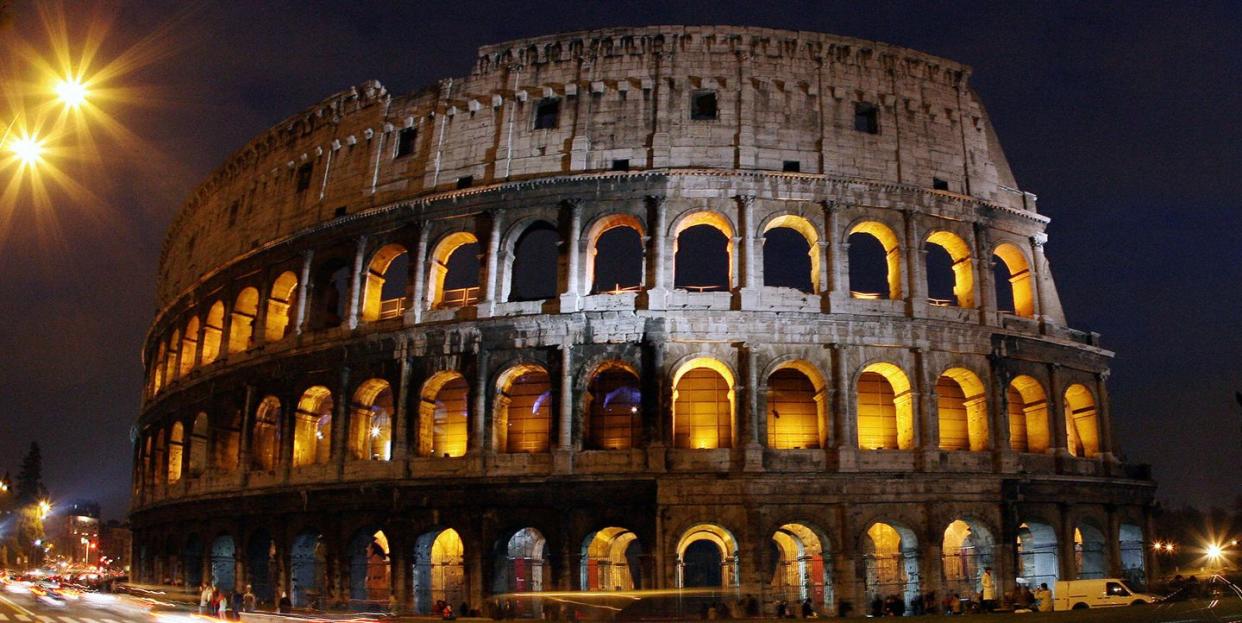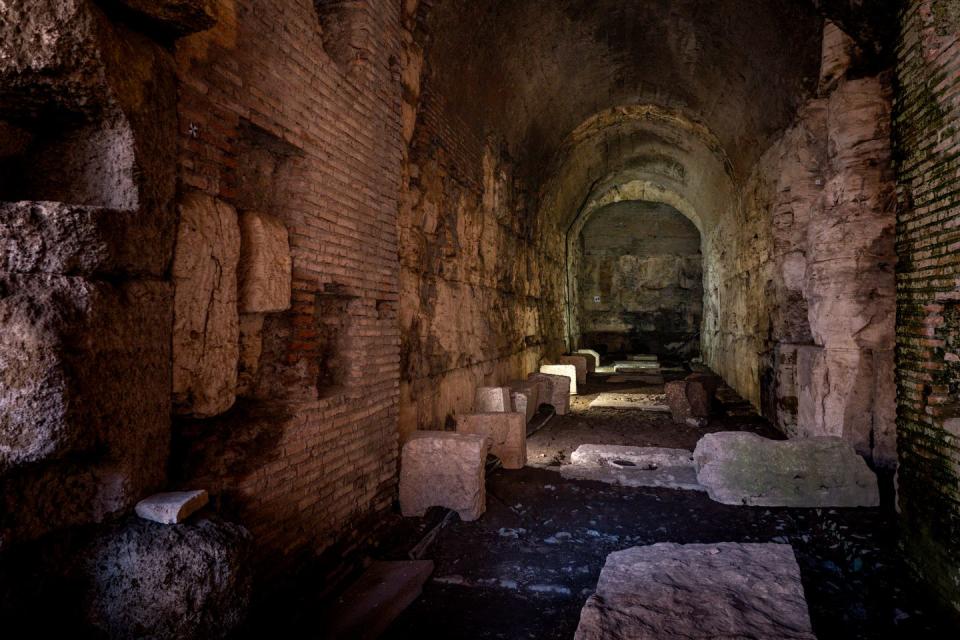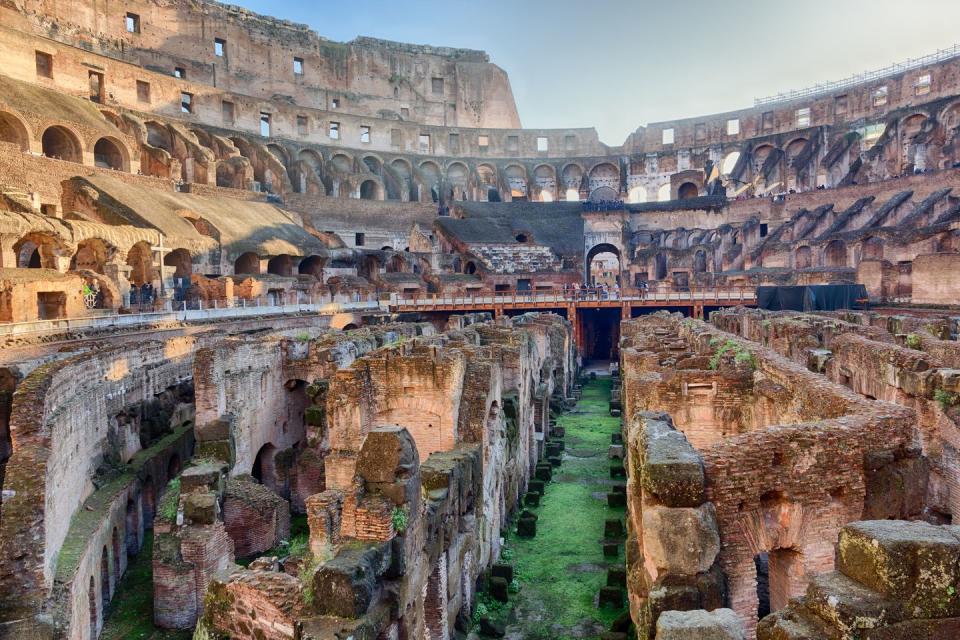You Could Have Eaten Pizza While Watching Shows at the Roman Colosseum 2,000 Years Ago

Italian archaeologists recently discovered the remains of meals in the drainage system of the Colosseum, revealing that certain meats, vegetables, and fruits were the snacks of choice for ancient Romans.
Archaeologists also unearthed the bones of bears, lions, leopards, and dogs in the drainage system.
Continued study of the Colosseum helps broaden our understanding of the events in the world’s first major amphitheater-style stadium.
For as long as citizens have gathered in stadiums for entertainment, they’ve done so with food in hand. A new announcement from the Colosseum Archaeological Park in Rome unveiled the results of a year-long study of the drainage system under the Colosseum, including foods found at the site, bones of animals believed used in events, and coins dating back to 170 AD.
🏟 You love ancient finds. So do we. Let’s dive deep into them together—join Pop Mech Pro.
“We have recovered traces of the remains of the meals that were eaten in the stands during the shows,” the organization says in a statement on Facebook.
Built in the first century, the Colosseum was first known as the Flavian Amphitheater due to the building being commissioned by the emperors of the Flavian dynasty. Designed to hold spectators at least 50,000 strong, the world’s first major entertainment stadium—and still the world’s largest amphitheater—was known for animal hunts, gladiatorial games, and spectacles aplenty. It served as a keystone of Roman culture until around the year 500. Now, the travertine monument stands as a tourist destination that’s yielding a wealth of evidence about ancient Roman habits and culture.
The discovery of ancient bones and meal remains is not common in the Colosseum. “The only places where such discoveries can be made are the sewers,” Federica Rinaldi, archaeological officer responsible for the Colosseum, tells Popular Mechanics. “The importance of this discovery is in the type of animals. Besides lions and bears used in the shows, remains of small dogs, chickens, and pigs were found. There are also many plant remains that illustrate the biodiversity of Roman times and the presence of evergreen plants used for ornamental purposes in the arena during the shows [and possibly] in the area surrounding the Colosseum.”

Thousands of citizens could have spent long days at the venue. The recent find shows that spectators snacked on a variety of meats, vegetables, and fruits. Pizza may even have entered the scene. Archeologists found remnants of olives, figs, grapes, peaches, plums, walnuts, cherries, hazelnuts, and blackberries. They also believe that the meat was “cooked at the moment on improvised braziers, together with some pizza,” according to the organization’s Facebook video.
During the archeological process, which began in January and used wire-guided robots that cleared about 230 feet of sewer, researchers uncovered animal-bone fragments ranging from bears and big cats to small dogs. They also located bronze coins from the late Roman period, according to Reuters, and a silver coin from around the year 170 that commemorated 10 years of Emperor Marcus Aurelius’ rule.
The oval-shaped Colosseum has a surface area of six acres. It runs 620 feet long, 511 feet wide, and stood 159 feet tall in its earlier period. It had 80 entrances—76 of them numbered and four considered grand entrances. The ellipse-shaped venue features three tiers of travertine limestone mined at the quarries of Tivoli 20 miles away and mixed with concrete, stone, tiles, and iron. In an architectural design not so unlike today’s modern stadiums, the tiered seating was based on a hierarchy, with the seats farthest from the action kept for those of less social standing—the ancient version of today’s cheap seats.

The southern sector, where the two outer sections have been collapsed since the Middle Ages, has great potential as the next important source for discovery. “Here we are excavating in order to reconstruct the history of the Colosseum,” Rinaldi says. The site undoubtedly holds more evidence that will fill in details about life in ancient Rome.
“The Colosseum continues to tell us its stories, emerging clearly in the wider flow of great history,” reads the organization’s statement. “Exposing the underground sewers, recovering the precious data of older investigations, we are studying to better understand the functioning of the ancient sewers and the hydraulics of the Flavian Amphitheater.”
Take a tour of the Colosseum’s drainage system, where these discoveries were recently found:
You Might Also Like

